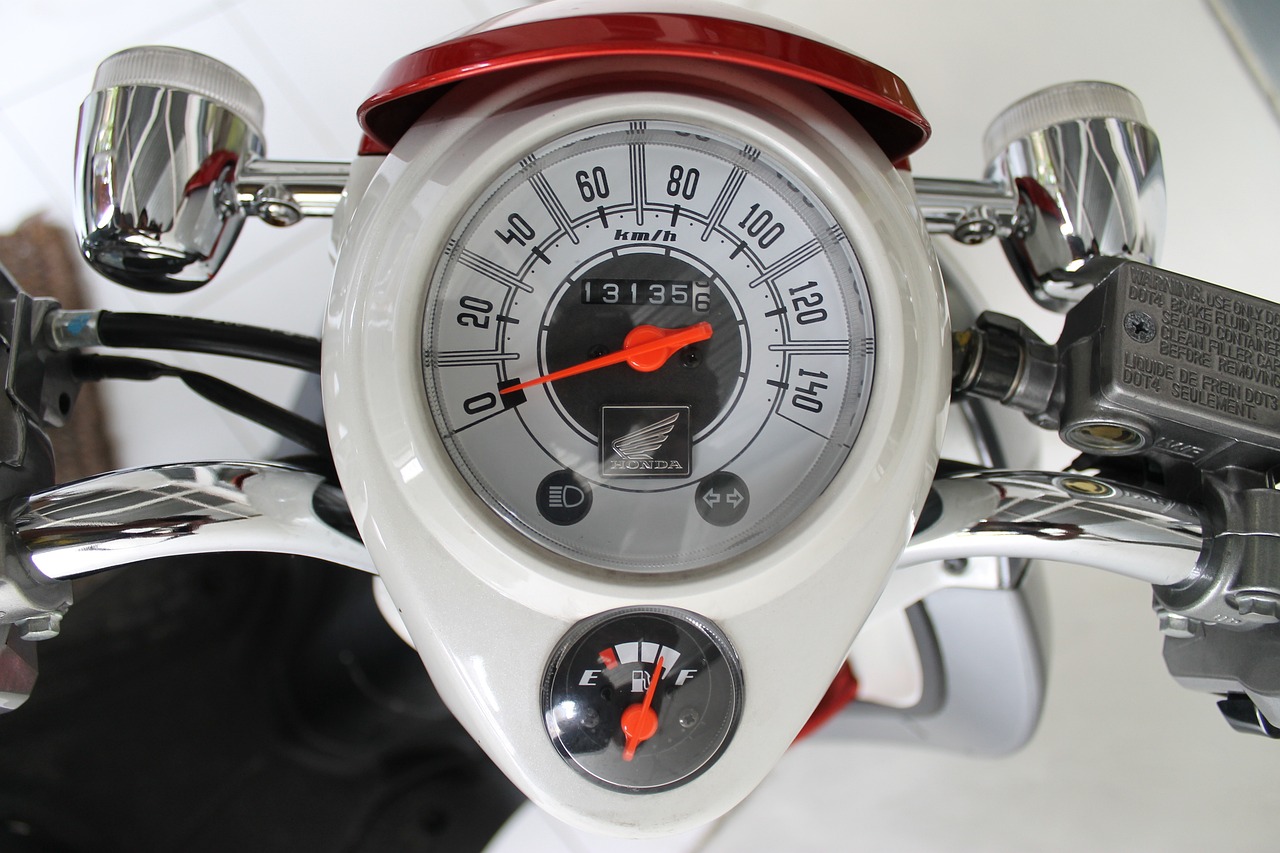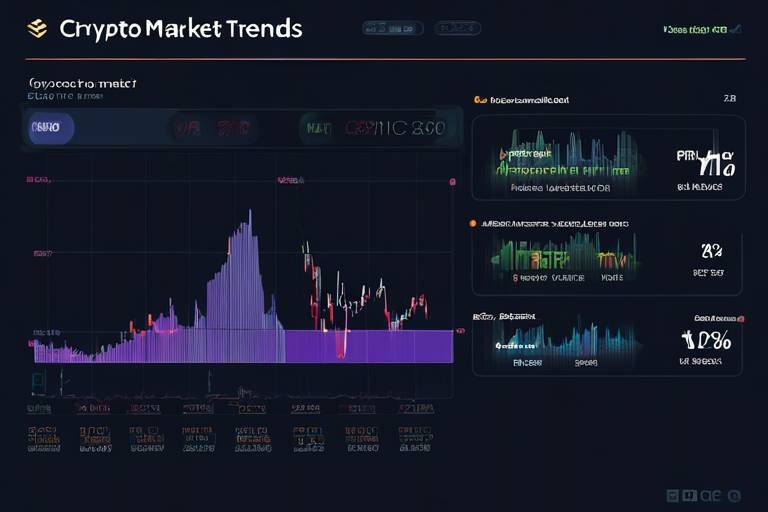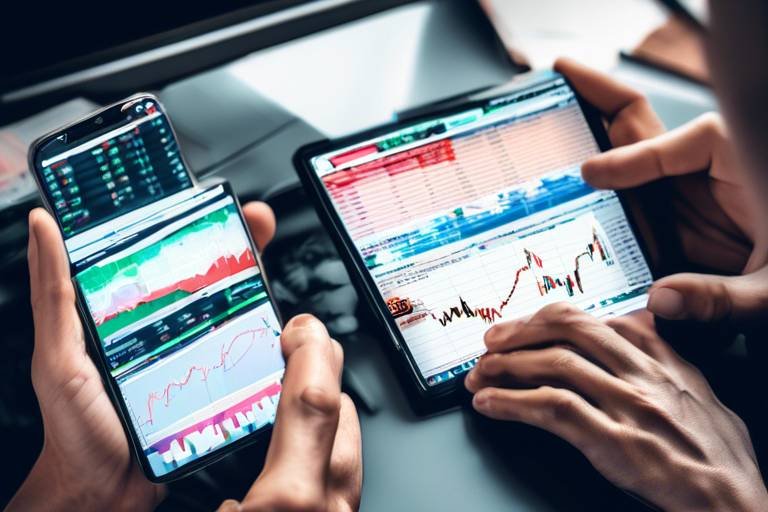How to Use Economic Indicators in Crypto Trading
In the ever-evolving world of cryptocurrency trading, understanding the nuances of the market is crucial for success. One of the key elements that can significantly influence trading strategies is the use of economic indicators. These metrics are like a compass, guiding traders through the turbulent waters of market fluctuations. By integrating economic indicators into your trading approach, you can make more informed decisions that enhance your potential for profit. But how exactly can these indicators be leveraged? Let’s dive into the details!
Economic indicators are statistics that provide insights into the overall health of an economy. Think of them as the vital signs of economic activity. In the context of cryptocurrency, these indicators can help traders anticipate market movements, identify trends, and adjust their strategies accordingly. For instance, when consumer confidence rises, it often leads to increased spending, which can drive demand in the crypto market. By familiarizing yourself with these metrics, you can gain a competitive edge in the fast-paced and often unpredictable world of crypto trading.
Economic indicators can be categorized into three main types: leading, lagging, and coincident. Each type serves a unique purpose and offers valuable insights for traders:
- Leading Indicators: These metrics, such as consumer confidence and stock market performance, can signal future economic activity. They are essential for anticipating market shifts before they occur.
- Lagging Indicators: Metrics like unemployment rates and GDP growth reflect past economic performance. While they may not predict future movements, they confirm trends and validate trading strategies.
- Coincident Indicators: These indicators occur at the same time as the economic activity they signify, providing real-time insights into the economy's current state.
Leading indicators are invaluable for traders looking to get ahead of the curve. For example, the Consumer Confidence Index (CCI) measures how optimistic consumers feel about the economy. A high CCI usually correlates with increased spending, which can positively impact the cryptocurrency market. Additionally, stock market trends can provide insights into investor sentiment. When the stock market is bullish, it often leads to increased investments in cryptocurrencies as traders seek higher returns. Understanding these indicators can help crypto traders anticipate market shifts before they occur.
The Consumer Confidence Index is a critical leading indicator. It gauges the optimism of consumers regarding the economy. When consumers feel confident, they are more likely to spend, which can lead to increased demand for cryptocurrencies. Consequently, a rising CCI can be a precursor to bullish trends in the crypto market.
Stock market trends are another essential leading indicator. A bullish stock market can indicate increased investor confidence, which often spills over into the crypto market. Traders should keep a close eye on stock market performance as it can provide hints about potential movements in cryptocurrency prices.
On the other hand, lagging indicators help confirm trends and validate trading strategies. For instance, metrics like unemployment rates and GDP growth provide insight into past economic performance. While they may not predict future movements, they are crucial for understanding the overall economic environment and can help traders make sense of current market conditions.
Incorporating economic indicators into your trading analysis can significantly enhance your decision-making process. By understanding how these indicators interact with crypto markets, traders can better position themselves for potential gains. For example, combining technical analysis with economic indicators allows traders to create a more comprehensive trading strategy. This dual approach can lead to better predictions and improved risk management.
Market sentiment is heavily influenced by economic indicators and plays a crucial role in crypto trading. Understanding sentiment can help traders gauge potential market movements. For instance, if economic indicators suggest a robust economy, traders may feel more optimistic and increase their investments in cryptocurrencies. Conversely, weak economic indicators may lead to a bearish sentiment, prompting traders to sell off their holdings. By staying attuned to market sentiment, traders can adjust their strategies accordingly and enhance their trading performance.
Implementing economic indicators into your trading routine requires practice and patience. Here are some practical tips to help traders effectively utilize these metrics:
- Stay updated on economic news and reports.
- Combine both technical and fundamental analysis for a holistic view.
- Monitor market sentiment closely, as it can shift rapidly.
- Practice risk management to mitigate potential losses.
By following these tips, traders can improve their understanding of economic indicators and make more informed trading decisions. In a market as volatile as cryptocurrency, having a solid grasp of economic indicators can be the difference between a successful trade and a missed opportunity.
1. What are economic indicators?
Economic indicators are statistics that provide insights into the overall health of an economy, helping traders anticipate market movements.
2. How can I use economic indicators in crypto trading?
By analyzing leading, lagging, and coincident indicators, traders can make informed decisions and adjust their strategies based on economic conditions.
3. What is the Consumer Confidence Index?
The Consumer Confidence Index measures how optimistic consumers feel about the economy, which can influence spending and, subsequently, cryptocurrency demand.
4. Why are lagging indicators important?
Lagging indicators confirm trends and validate trading strategies by providing insights into past economic performance.
5. How can I stay updated on economic indicators?
Follow economic news, subscribe to financial newsletters, and use trading platforms that provide real-time economic data.

Understanding Economic Indicators
Economic indicators are like the pulse of the economy; they provide critical insights that help us gauge its health. Imagine trying to navigate a stormy sea without a compass—economic indicators serve as that compass for traders in the unpredictable waters of cryptocurrency. By familiarizing yourself with these metrics, you can anticipate market movements and make strategic decisions that could significantly impact your trading success.
To put it simply, economic indicators are statistical data points that reflect the overall economic performance of a country or region. They can help traders understand whether an economy is expanding, contracting, or remaining stable. This understanding is crucial for anyone involved in crypto trading, where market sentiment can swing wildly based on economic news and trends.
There are three primary categories of economic indicators: leading, lagging, and coincident. Each type plays a unique role in providing insights that can be pivotal for predicting market trends. For example, leading indicators can offer clues about future economic activities, while lagging indicators help us confirm what has already happened. Coincident indicators, on the other hand, reflect the current state of the economy.
Understanding how these indicators interact with the cryptocurrency market can give traders a distinct advantage. For instance, if you notice a rise in leading indicators like consumer confidence or stock market performance, it might suggest that investors are feeling optimistic, which could lead to increased investment in cryptocurrencies. Conversely, if lagging indicators such as rising unemployment rates are reported, it might signal a downturn, prompting traders to reconsider their positions.
In essence, economic indicators are not just numbers; they tell a story about the economy that can help you make informed trading decisions. By keeping an eye on these metrics, you can position yourself better in the market and enhance your overall trading strategy. So, the next time you hear about economic reports, remember that they are more than just statistics—they are vital tools that can guide your trading journey.

Types of Economic Indicators
When diving into the world of cryptocurrency trading, understanding the is crucial for making informed decisions. Economic indicators are statistical metrics that provide insights into the economic performance of a country or region. They can be categorized mainly into three types: leading, lagging, and coincident indicators. Each type serves a unique purpose and can significantly influence trading strategies in the volatile crypto market.
Leading indicators are like the crystal balls of economic forecasting. They provide predictions about future economic activity, allowing traders to anticipate market movements. For instance, metrics such as the Consumer Confidence Index (CCI) and stock market performance often serve as leading indicators. When consumer confidence is high, it typically suggests that people are willing to spend more, which can lead to increased investments in cryptocurrencies.
On the other hand, we have lagging indicators, which reflect past economic performance. These indicators, including the unemployment rate and Gross Domestic Product (GDP) growth, can confirm trends but do not predict future movements. For instance, if the GDP is growing steadily, it might indicate a healthy economy, but it won’t tell you what the market will do next. Instead, it can validate your trading strategy by confirming that you're on the right path.
Lastly, coincident indicators move in tandem with the economy. They provide real-time data that reflects the current state of economic activity. Examples include industrial production and retail sales. These indicators are essential for traders who want to gauge the immediate effects of economic changes on the cryptocurrency market.
Understanding these types of economic indicators is vital for traders looking to enhance their strategies. By leveraging leading indicators, traders can get ahead of the curve, while lagging and coincident indicators can help confirm their decisions. The interplay between these indicators can create a comprehensive picture of the economic landscape, ultimately guiding traders in navigating the often unpredictable waters of cryptocurrency trading.

Leading Indicators
Leading indicators are like the early warning signals of the economic landscape, providing traders with a sneak peek into potential future movements in the market. These indicators can be incredibly valuable for crypto traders, as they help in anticipating shifts before they actually happen. Imagine standing on a beach, watching the waves roll in; leading indicators are akin to the way you can see the tide pulling back, hinting that a big wave is about to crash. By understanding these signals, traders can make informed decisions that could lead to significant gains.
Some of the most notable leading indicators include the Consumer Confidence Index and stock market performance. The Consumer Confidence Index, for instance, gauges how optimistic consumers feel about the economy. When this index is high, it typically means people are feeling good about their financial situation and are likely to spend more. This increased spending can have a ripple effect, positively influencing the crypto market as more money flows into various assets. Conversely, a low index may signal economic troubles ahead, leading to a more cautious approach from traders.
Another key leading indicator is stock market trends. The stock market often serves as a barometer for investor sentiment. When the stock market is bullish—meaning prices are rising—traders may feel more confident and are likely to seek out higher returns in the crypto space. This could lead to a surge in cryptocurrency investments, driving prices up. Conversely, a bearish stock market might make investors hesitant, causing them to pull back from crypto investments. Understanding this relationship can give traders a competitive edge, allowing them to navigate the volatile waters of cryptocurrency trading with more confidence.
In summary, leading indicators are essential tools that can provide insights into future market movements. By keeping an eye on the Consumer Confidence Index and stock market trends, traders can position themselves strategically, making well-informed decisions that could enhance their trading outcomes. Remember, in the world of crypto, being proactive rather than reactive is key to success.

Consumer Confidence Index
The Consumer Confidence Index (CCI) is a vital economic indicator that gauges how optimistic or pessimistic consumers feel about the overall state of the economy and their personal financial situations. This index is calculated based on surveys conducted with a diverse group of households, where respondents share their views on current economic conditions and their expectations for the future. When consumers feel confident, they are more likely to spend money, which can lead to economic growth. Conversely, a decline in consumer confidence can signal economic downturns, making it essential for crypto traders to keep a close eye on this metric.
So, why should crypto traders care about the CCI? Well, the connection between consumer confidence and cryptocurrency markets can be quite profound. A high CCI often correlates with increased consumer spending, which can lead to greater investment in assets, including cryptocurrencies. When people feel secure in their financial situation, they are more willing to take risks, such as investing in volatile markets like crypto. On the flip side, a low CCI might indicate that consumers are tightening their belts, which could lead to reduced investment in cryptocurrencies and a potential downturn in prices.
To illustrate the impact of consumer confidence on the crypto market, consider the following table that summarizes how changes in the CCI can influence market behavior:
| CCI Level | Consumer Behavior | Potential Impact on Crypto Market |
|---|---|---|
| High | Increased spending and investment | Potential price surge in cryptocurrencies |
| Moderate | Cautious spending | Stable or slow growth in crypto prices |
| Low | Decreased spending and risk aversion | Potential price decline in cryptocurrencies |
In summary, the Consumer Confidence Index is not just a number; it is a reflection of the mood of consumers and their willingness to engage in economic activities. For crypto traders, understanding the CCI can provide crucial insights into potential market movements. By monitoring consumer sentiment, traders can better position themselves to capitalize on opportunities or mitigate risks in the ever-changing landscape of cryptocurrency trading.
- What is the Consumer Confidence Index? The CCI measures consumer sentiment regarding the economy and personal finances, influencing spending and investment behaviors.
- How often is the CCI published? The CCI is typically published monthly, providing timely insights into consumer sentiment.
- Why is the CCI important for crypto traders? The CCI can indicate potential market movements based on consumer willingness to invest, impacting cryptocurrency prices.

Stock Market Trends
The stock market is often viewed as a barometer of economic health, and its trends can have a profound impact on the cryptocurrency landscape. When the stock market is performing well, it tends to instill a sense of confidence among investors. This optimism can spill over into the crypto markets, leading to increased investments in digital assets. Conversely, when the stock market is in decline, fear and uncertainty may cause investors to pull back from riskier assets like cryptocurrencies.
Understanding stock market trends is crucial for crypto traders. For instance, a bullish stock market, characterized by rising prices and investor enthusiasm, can create a favorable environment for cryptocurrencies. Traders often look for correlations between stock indices, such as the S&P 500 or NASDAQ, and major cryptocurrencies like Bitcoin and Ethereum. When these indices rise, it can signal a potential influx of capital into the crypto market as investors seek higher returns.
Moreover, the relationship between traditional markets and cryptocurrencies is not always straightforward. Sometimes, cryptocurrencies may decouple from stock market trends, leading to unique trading opportunities. For example, during periods of economic uncertainty, some investors might turn to cryptocurrencies as a hedge against inflation or currency devaluation. This behavior can create a surge in crypto prices even when the stock market is struggling.
To illustrate the relationship between stock market trends and crypto movements, consider the following table:
| Stock Market Trend | Potential Impact on Crypto Market |
|---|---|
| Bullish | Increased investment in cryptocurrencies as investors seek higher returns. |
| Bearish | Potential withdrawal from crypto markets, leading to price declines. |
| Sideways | Market indecision; traders may look for alternative strategies. |
In summary, stock market trends are not just numbers on a screen; they reflect investor sentiment and economic conditions that can significantly influence the crypto market. Understanding these trends allows traders to make informed decisions and adjust their strategies accordingly. The key is to remain vigilant and responsive to changes in both markets, as they can often provide valuable insights into future price movements in the world of cryptocurrencies.
- How do stock market trends affect cryptocurrency prices?
Stock market trends can influence investor sentiment, leading to increased or decreased investments in cryptocurrencies based on the overall economic outlook. - What indicators should I watch in the stock market?
Key indicators include the S&P 500, NASDAQ, and Dow Jones Industrial Average, as well as consumer confidence and unemployment rates. - Can cryptocurrencies act independently of stock market trends?
Yes, there are times when cryptocurrencies may rise or fall based on their own market dynamics, independent of stock market performance. - How can I use stock market trends to improve my crypto trading strategy?
By analyzing stock market trends, traders can anticipate potential shifts in investor sentiment and adjust their crypto trading strategies accordingly.

Lagging Indicators
Lagging indicators serve as vital tools for traders looking to understand past economic performance and confirm existing trends. Unlike leading indicators, which attempt to forecast future movements, lagging indicators provide a retrospective view that can validate trading decisions. Think of lagging indicators as the rearview mirror of economic analysis; they reflect what has already happened, allowing traders to gauge the effectiveness of their strategies.
Some of the most notable lagging indicators include unemployment rates and Gross Domestic Product (GDP) growth. These metrics can often help traders assess the overall economic climate and its impact on the cryptocurrency market. For instance, when unemployment rates are high, consumer spending typically decreases, which could lead to reduced investment in cryptocurrencies. Conversely, a growing GDP may indicate a healthy economy, potentially leading to increased interest in digital assets.
To illustrate the role of lagging indicators, let’s take a closer look at the unemployment rate and GDP growth:
| Indicator | Description | Impact on Crypto Trading |
|---|---|---|
| Unemployment Rate | Measures the percentage of the labor force that is unemployed and actively seeking employment. | High unemployment can lead to decreased consumer spending, negatively impacting crypto investments. |
| GDP Growth | Indicates the rate at which a country's economy is growing or shrinking. | Positive GDP growth typically encourages investment in various asset classes, including cryptocurrencies. |
While lagging indicators may not provide immediate insights into future market movements, they are essential for confirming trends. For example, if you notice that the unemployment rate is declining while GDP is growing, it may suggest a strengthening economy. This combination could encourage traders to adopt a more bullish stance on crypto investments. Ultimately, the key to successful trading lies in understanding how these indicators work together to paint a complete picture of the market landscape.
Incorporating lagging indicators into your trading strategy can enhance your ability to make informed decisions. By analyzing these metrics alongside other forms of analysis, you can develop a more nuanced understanding of market movements. Remember, while lagging indicators don’t predict the future, they can provide valuable confirmation that helps you navigate the often turbulent waters of cryptocurrency trading.

Using Economic Indicators in Analysis
Incorporating economic indicators into your trading analysis can significantly enhance your decision-making process. These indicators serve as a compass, guiding traders through the unpredictable waters of the cryptocurrency market. By understanding how these metrics influence market movements, you can position yourself more strategically for potential gains. Think of economic indicators as the weather forecast for trading; knowing whether it's sunny or stormy can help you decide whether to take your umbrella—or in this case, whether to buy or sell.
When diving into the world of crypto trading, it’s essential to blend both technical analysis and economic indicators. Technical analysis focuses on price movements and trading volume, while economic indicators give context to those movements by reflecting broader economic conditions. This dual approach can lead to better predictions and improved risk management. For instance, if a technical chart shows a bullish trend but economic indicators suggest a looming recession, it might be wise to exercise caution.
Moreover, understanding market sentiment is crucial in this mix. Market sentiment is often influenced by economic indicators, and it plays a vital role in crypto trading. Traders' perceptions can drive prices up or down, sometimes regardless of what the actual data says. By analyzing sentiment along with economic indicators, you can gauge potential market movements more accurately. For example, if consumer confidence is high and the stock market is performing well, traders may feel optimistic about investing in cryptocurrencies, leading to price increases.
To effectively utilize economic indicators in your trading analysis, consider the following strategies:
- Stay Updated: Regularly review economic reports and news releases that can impact market sentiment.
- Analyze Trends: Look for patterns in economic indicators and how they correlate with crypto price movements.
- Combine Data: Use both technical analysis and economic indicators to form a comprehensive view of the market.
In conclusion, using economic indicators in your analysis can provide a more rounded perspective on market conditions. By integrating these insights into your trading strategy, you can make more informed decisions and potentially enhance your trading performance. Remember, the crypto market is not just about numbers on a chart; it’s about understanding the underlying economic forces that drive those numbers.
Q1: How can economic indicators affect cryptocurrency prices?
Economic indicators can influence trader sentiment and expectations regarding the future performance of the economy, which in turn can affect cryptocurrency prices. For example, a strong jobs report may boost confidence in the economy, leading to increased investment in cryptocurrencies.
Q2: What are some key economic indicators to watch for crypto trading?
Some key economic indicators include the Consumer Confidence Index, unemployment rates, GDP growth, and stock market performance. These indicators can provide valuable insights into market trends.
Q3: How often should I review economic indicators?
It’s advisable to review economic indicators regularly, especially around major economic reports and announcements. Staying informed can help you anticipate market movements and adjust your trading strategy accordingly.
Q4: Can I rely solely on economic indicators for trading decisions?
While economic indicators are valuable tools, it’s best to use them in conjunction with technical analysis and market sentiment for a more comprehensive trading strategy.

Technical vs. Fundamental Analysis
When it comes to navigating the wild waters of cryptocurrency trading, understanding the difference between technical analysis and fundamental analysis is like having a compass and a map. Each approach offers unique insights, and knowing how to use them together can be a game changer for traders looking to maximize their profits.
Technical analysis focuses on historical price movements and trading volume. Traders analyze charts and patterns to predict future price actions. Think of it like reading the waves at the beach; by observing past movements, you can anticipate how the waves will behave in the future. Traders use various tools, such as moving averages, Relative Strength Index (RSI), and Fibonacci retracements, to identify potential entry and exit points in the market.
On the flip side, fundamental analysis dives deep into the underlying factors that can influence the value of a cryptocurrency. This includes studying economic indicators, news events, and the overall health of the market. For instance, if a country announces new regulations on cryptocurrency, it can significantly impact prices. It’s akin to understanding the weather before going sailing; knowing the conditions can help you avoid storms and navigate more smoothly.
To illustrate the differences, let's break it down in a simple table:
| Aspect | Technical Analysis | Fundamental Analysis |
|---|---|---|
| Focus | Price movements and patterns | Economic indicators and market factors |
| Tools | Charts, indicators, patterns | News, reports, economic data |
| Time Frame | Short-term trading | Long-term investment |
| Approach | Quantitative | Qualitative |
Both analyses have their strengths and weaknesses. Technical analysis is fantastic for short-term traders who thrive on quick trades and rapid market movements. However, it can sometimes miss the bigger picture. On the other hand, fundamental analysis provides a broader view of market conditions, but it may not be as effective for those looking to capitalize on immediate price changes.
The magic happens when traders combine both approaches. By integrating technical indicators with economic data, traders can create a more robust strategy. For instance, if technical analysis indicates a potential price breakout while fundamental analysis reveals positive economic indicators, it might be a good time to enter a trade. This dual approach not only enhances decision-making but also improves risk management, allowing traders to adapt to changing market conditions effectively.
In conclusion, mastering both technical and fundamental analysis is essential for any serious crypto trader. By understanding how to leverage these two methodologies, you can position yourself to make informed decisions, navigate the volatile crypto landscape, and ultimately increase your chances of success.

Market Sentiment Analysis
Market sentiment analysis is a crucial aspect of cryptocurrency trading, as it provides insights into how traders and investors feel about the market at any given moment. Think of it as the collective mood of the market; just like how the weather can change rapidly, so can the sentiment in the crypto world. This can be influenced by various factors, including economic indicators, news events, and social media trends. When traders are optimistic, they are likely to buy more, pushing prices up. Conversely, when fear grips the market, selling can lead to price drops.
Understanding market sentiment can empower traders to make more informed decisions. For instance, if you notice a surge in positive sentiment following a favorable economic report, it might be a good time to enter a position. On the other hand, if negative sentiment prevails due to adverse news, it could signal a time to exit or short the market. To effectively gauge sentiment, traders often look at various indicators, such as:
- Social Media Trends: Monitoring platforms like Twitter and Reddit can reveal how traders are feeling about specific cryptocurrencies.
- News Sentiment: Analyzing headlines and articles can provide context on how news affects market perception.
- Sentiment Analysis Tools: Various online tools and platforms aggregate data to give a sentiment score for different cryptocurrencies.
Moreover, it's essential to recognize that sentiment can be fleeting. Just because the market is bullish today doesn't mean it will be tomorrow. Therefore, combining sentiment analysis with economic indicators can create a more robust trading strategy. For example, if economic data shows growth but sentiment is negative, it may be wise to tread carefully.
In summary, market sentiment analysis is not just about feeling the pulse of the market; it's about understanding how emotions can drive prices. By integrating sentiment analysis into your trading routine, you can enhance your ability to predict market movements and make more strategic decisions. Remember, in the world of crypto, staying ahead of the curve is crucial, and understanding sentiment is a key part of that equation.
Q1: What is market sentiment analysis?
A1: Market sentiment analysis involves gauging the overall mood of the market to understand how traders feel about a particular cryptocurrency or the market as a whole. This can help predict price movements.
Q2: How can I measure market sentiment?
A2: You can measure market sentiment through various means, including social media monitoring, news analysis, and using sentiment analysis tools that aggregate data and provide sentiment scores.
Q3: Why is market sentiment important in crypto trading?
A3: Market sentiment is important because it can significantly influence price movements. A positive sentiment can drive prices up, while negative sentiment can lead to declines. Understanding this can help traders make more informed decisions.
Q4: Should I rely solely on market sentiment for trading decisions?
A4: No, while market sentiment is valuable, it should not be the only factor in your trading decisions. Combining sentiment analysis with economic indicators and technical analysis can lead to a more comprehensive trading strategy.

Practical Tips for Traders
When it comes to trading cryptocurrencies, understanding and utilizing economic indicators can be a game-changer. To effectively integrate these metrics into your trading strategy, consider the following practical tips that can enhance your decision-making process and boost your trading performance.
First and foremost, stay informed. Economic indicators are constantly being updated, and keeping an eye on the latest reports can help you anticipate market movements. This means subscribing to financial news outlets, following relevant social media accounts, and using apps that provide real-time updates. Remember, knowledge is power in the fast-paced world of crypto trading!
Next, create a trading journal. Documenting your trades, the economic indicators you considered, and the outcomes can help you identify patterns in your decision-making process. Over time, this journal will serve as a valuable resource for refining your strategy. By analyzing your past trades, you can determine which indicators were most predictive of market movements and adjust your approach accordingly.
Another essential tip is to develop a balanced approach. While economic indicators are crucial, they should not be your only focus. Consider combining them with technical analysis to form a more holistic view of the market. For instance, if economic indicators suggest a bullish trend, but technical analysis shows resistance levels, you might want to be cautious before making a move.
Moreover, practice risk management. This is vital in any trading strategy, especially in the highly volatile crypto market. Use economic indicators to set stop-loss orders and position sizes that align with your risk tolerance. By doing so, you can protect your capital while still taking advantage of potential market opportunities.
Lastly, engage with a community. Joining forums or groups focused on crypto trading can provide you with insights from other traders who also utilize economic indicators. Sharing experiences and strategies can lead to new ideas and approaches that you may not have considered. Plus, it’s always nice to have a support system as you navigate the ups and downs of trading!
In summary, leveraging economic indicators in your trading strategy requires a proactive approach. By staying informed, maintaining a trading journal, combining analyses, practicing risk management, and engaging with the community, you can significantly enhance your trading performance. Remember, the world of cryptocurrency is ever-evolving, and adapting your strategies to include economic indicators can lead to more informed and successful trading decisions.
- What are economic indicators? Economic indicators are statistics that provide insights into the overall health of an economy, helping traders anticipate market movements.
- How can I track economic indicators? You can track economic indicators by following financial news websites, using dedicated financial apps, and subscribing to economic calendars.
- Why should I combine technical and fundamental analysis? Combining both analyses allows for a more comprehensive trading strategy, enhancing predictions and improving risk management.
- What is the importance of a trading journal? A trading journal helps you document your trades and the economic indicators considered, allowing you to identify patterns and refine your strategy over time.
Frequently Asked Questions
- What are economic indicators and why are they important in crypto trading?
Economic indicators are statistical metrics that provide insights into the overall health of an economy. In the context of crypto trading, they help traders anticipate market movements and make informed decisions. By understanding these indicators, traders can better position themselves in the volatile cryptocurrency market.
- What are the different types of economic indicators?
There are three main types of economic indicators: leading, lagging, and coincident. Leading indicators, like consumer confidence, can signal future economic activity. Lagging indicators, such as unemployment rates, confirm trends based on past performance. Coincident indicators provide information about the current state of the economy.
- How can I use leading indicators in my trading strategy?
Leading indicators can be incredibly useful for predicting market shifts before they happen. For example, tracking the Consumer Confidence Index can help you gauge how optimistic consumers are, which may influence their spending and, subsequently, the crypto market. By staying ahead of these indicators, you can make more strategic trading decisions.
- What role do lagging indicators play in crypto trading?
Lagging indicators provide insights into past economic performance and can confirm existing trends. While they might not predict future movements, understanding these indicators, like GDP growth, can validate your trading strategies and help you avoid potential pitfalls.
- How do I combine technical analysis with economic indicators?
Combining technical analysis with economic indicators allows for a more comprehensive trading strategy. By analyzing price charts alongside economic data, traders can improve their predictions and enhance risk management, leading to more informed trading decisions.
- How does market sentiment affect crypto trading?
Market sentiment, which can be influenced by economic indicators, plays a crucial role in crypto trading. Understanding how sentiment shifts can help you gauge potential market movements, allowing you to adjust your strategies accordingly and capitalize on emerging trends.
- What practical tips can I follow to effectively use economic indicators?
To effectively utilize economic indicators, start by regularly monitoring key metrics and integrating them into your trading routine. Stay updated on economic news, analyze historical data, and practice combining these indicators with your existing strategies to enhance your decision-making process.



















